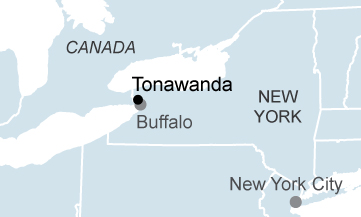 Not everything always has to to go from bad to worse. A little money can make a difference.
Not everything always has to to go from bad to worse. A little money can make a difference.
This week’s news that officials in Tonawanda, N.Y., had settled for a very low tax-payment adjustment from owners of the retired Huntley coal plant means an enormous loss in revenues to the city, the town and the school district. Schools alone in Tonawanda are losing $2.7 million.
The hit to local tax coffers was treated as no big deal by the Buffalo News, and indeed it could have been devastating. But it wasn’t. The reason? The people of western New York and their elected officials, including Gov. Andrew Cuomo, worked together to enact an appropriation last year to help communities recover after losing vital tax revenue when coal plants fail.
The Tonawanda school district has already applied to the appropriate state agency for the funding, and what could have been a frantic scramble in the first weeks of the new school year to repair budget damage will now likely be what it’s supposed to be: a time when kids learn, teachers teach and maintenance staff welcome everyone back to a shined-up school.
The best part of this transition is that taxes did not have to be raised in a community that is struggling already. The burden is shared instead by all New Yorkers.
The outcome is the result of groundwork that began well in advance of the moment. A coalition of residents, community activists, environmentals, labor unions and elected officials got together about two years ago to plan for the inevitable closure of the plant. The group worked with the state legislature to put together a bill to create mitigation fund that would be available to help local schools, especially, make ends meet during difficult times.
The plan is working.
But of course the work does not end here. The Huntley plant closure puts jobs at risk all across the community—the town’s entire economy is at risk—and underscores the need for new economic development of the sort that is occurring less than a half an hour south of town. In Buffalo, Solar City is constructing a solar-panel factory that is scheduled to employ 50 to 100 people by 2017 and—if plans unfold as expected—could add an additional 100 jobs over the next few years. Solar is a growing industry, and the Solar City facility is engendering cautious optimism, a rare thing in recent times in western New York.
I have a recollection of a child’s poem that speaks to our friends in Tonawanda and beyond. Its title: In a Storm.
Gather Friends
Count the Children
Build a boat
Sail by the Stars
Find a new rainbow
Tonawanda isn’t graced yet with a rainbow, but the community has patiently gathered friends, and friends have brought wisdom and tools. Residents have used a time of uncertainty to put the children first and have found a way forward. The intent is simple, the task is difficult.
In many communities across the county where coal plants and mines are closing, industry and political leaders—in disappointing contrast to what is happening in Tonawanda—have chosen to point fingers, look out only for themselves, burn bridges, curse the darkness, and scorn the future.
Such reaction means only that job losses will mount, schools will go underfunded, people will lose both hope and opportunity, and bitterness will turn to paralysis.
The Tonawanda example shows that it doesn’t have to be that way.
Tom Sanzillo is IEEFA’s director of finance.
RELATED POSTS
In Western New York, an Instructive Tale of Two Coal-Fired Plants
Appalachia Needs More Than the Sound and Fury of the ‘War on Coal’ Canard
















